Friday, November 26, 2010
Always Coca-Cola 1993
One of my favorite Coca-Cola commercials is an “Always Coca-Cola” ad from 1993. It has the rapidly changing images behind the traditional Coke red disk logo (see video, above). The appeal of the commercial is not so much from the imagery, but rather the catchy jingle that accompanies it. I like it so much I actually have the 3 minute version of the song on my music player and listen to it often. It’s a song that can always makes you happy.
The ad came about when Coke was looking to improve its advertising in the early 90s. The work of their traditional ad agency had gotten bland and boring. To turn it around, the company made the bold move of handing responsibility for the ads of its flagship brands of Coke and Classic Coke not to a different ad agency, but rather to a Hollywood talent agency. The agency was Creative Artists Agency (CAA), headed by Michael Ovitz.
What CAA did was unconventionally to pitch to Coke the creation of a large number of commercials that would be targeted to specific market segments, and be tailored to fit whatever would work best for those groups. This was different from the standard cohesive look and theme for Coca-Cola ad campaigns. The only consistencies between the ads would be the use of the “Always Coca-Cola” slogan, the contoured Coke bottle, and the red disc logo (and perhaps some sense of “always”).
CAA went on to make over two dozen, very distinct commercials for the start of the campaign in February, 1993. That was a lot considering in 1992 there had been only seven commercials used in the whole year.
The commercials used the familiar contour bottle and red disc logo because Coca-Cola didn’t want to alienate their existing loyal customers. Nevertheless, at the same time, the company wanted to attract and gain the loyalty of new drinkers, specifcally, young people. Coke and CAA figured that to sell to Gen X, who were cynical about ads (having been immersed with TV ads their entire lives), the focus needed to be on entertaining and grabbing attention. So for this early MTV generation, whose attention span was said to be reduced because of the quick cuts in music videos, an ad with a flashing background should work well with them. In fact this ad above did run on MTV for those attention deficient consumers.
The jingle in the song was written by the song writing/producing team of Terry Coffey and Jon Nettlesbey. They had signed on with CAA in the early 90’s with the intention of working on film scores, but for the new Coke campaign, CAA asked them if they could write a commercial jingle.
In an interview with SongwriterUniverse, Coffey and Nettlesbey explained how Coffey recorded the upbeat track and Nettlesbey wrote the lyrics. Nettlesbey said he wrote verses about positive things that were always around, just like Coca-Cola. For the chorus, it was circumstance that produced the result. The pair had performed a demo of the song for the Coke execs before the words of the chorus had been written, so they just sang “Do do do do do - Always Coca-Cola.” When the Coke executives heard the demo, they liked the “Do do do do do” so much that it was left just as it was.
Joey Diggs is the singer who sang the jingle for commercial. Here is his 3 minute version of the song: http://www.youtube.com/watch?v=lgayORZ0CTY The song was also recorded in a dance version by Un Disco Latina: http://www.youtube.com/watch?v=_523um0UDcc I have the dance version on LP. I’m told that Coke workers in Atlanta would dance to this tune at the time in the nightclubs of the city.
While this is my favorite of the set of 1993 CAA Coke commercials, it's definitely didn't end up as the favorite of the general public. That distinction went to the stars of Coke's "Northern Lights" commercial, the animated polar bears.
Sunday, November 21, 2010
Advance Australia Fair
Of course The Star Spangled Banner is my favorite national anthem, but my second favorite is Australia's Advance Australia Fair. The melody is stirring and joyful and the lyrics are meaningful. It makes me wish my home were also girt by sea.
It has only been the official anthem since 1984, although the song dates back to 1878. It originally had 4 verses, which were whittled down to just two in its official form. Understandably, several references were removed about Australia just being an extension of England, along with Australia's mixed feelings about Britannia: "With all her faults we love her still."
My favorite performance of the song is the one at the opening ceremony of the 2000 Olympics (see video). I love the harmony of Human Nature and the strength of Julie Anthony's voice.
Friday, August 27, 2010
Palace Of Odysseus Found In Ithaca?
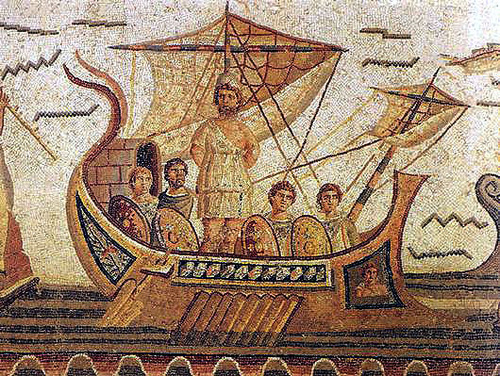
A team of archaeologists claims they have found the palace of Odysseus, the mythical king of Ithaca who fought in the Trojan War and who famously took 10 years to find his way home after the war ended.
Despite the fantastical stories about Odysseus told in the Odyssey, the archaeologists believe there is some truth to his existence and that the palace they discovered on the island of Ithaca, in the Ionian sea off the north-west coast of Greece, belonged to him.
A team from the University of Ioannina found the remains of the extensive three story building. The palace complex features a well from the 8th century BC, which is approximately the period in which Odysseus is believed to have been king of Ithaca.
However, it’s still questionable as to whether or not Odysseus actually existed. Also, some believe that ancient Ithaca was not in the same location as its modern namesake. They believe ancient Ithaca was located on the Paliki peninsula, on the island of Cephalonia.
Sing to me of the man, Muse, the man of twists and turns driven time and again off course, once he had plundered the hallowed heights of Troy.
Wednesday, August 25, 2010
Kodak 1922 Kodachrome Film Test
This is the 1922 Kodachrome Motion Picture Test No. III made at Paragon Studios in Fort Lee, New Jersey. It’s stunningly beautiful in its simplified color and tenebrist style with illuminated subjects and black background. It is one of the earliest color film examples existing.
The test footage includes actresses Mae Murray and Hope Hampton, with the latter modeling costumes from the movie The Light in the Dark (1922), which contained the first commercial use of Two-Color Kodachrome in a feature film. Ziegfeld Follies actress Mary Eaton and an unidentified woman and child also appear.
The Two-Color Kodachrome Process was an attempt to give natural lifelike colors to film using a subtractive color system. The subtractive part is done by using a dual-lens camera with color filters to record images on black/white negative stock. The negatives would show not just light and dark, but with color filters, show where the unfiltered color existed (or didn’t exist depending on your perspective). Through a complicated process of treating the negatives and dyeing one side of the finished film stock (that had double sided emulsion) with green/blue and red on the other, a range of colors could be produced.
A full three color process was used in a full length feature film for the first time 13 years later, in 1935.
Tuesday, August 24, 2010
Ob-La-Di, Ob-La-Da For Fun
This may be the best version of Ob-La-Di, Ob-La-Da ever made. It’s classic.
The Gameboy Music Club formed in the Summer of 2002. A lot of their music is created using music programs and the Nintendo Game Boy. The objective is to provide general and simple access to the infinite world of the present day music. It’s about the allure of using a cheap electronic musical instrument and music software and reducing music to the essentials.
The Gameboy Music Club formed in the Summer of 2002. A lot of their music is created using music programs and the Nintendo Game Boy. The objective is to provide general and simple access to the infinite world of the present day music. It’s about the allure of using a cheap electronic musical instrument and music software and reducing music to the essentials.
Thursday, August 19, 2010
Forma Urbis Romae: The Severan Marble Plan Is Tantalizing Jigsaw Puzzle From Hell
The Forma Urbis Romae, or Severan Marble Plan, was an immense 3rd century map of the
city of ancient Rome,
carved into 150 adjoining slabs of marble and covering a wall rising over four stories
tall. It was created at an approximate scale of 1:240 and measured 60’
wide by 45’ high. The map depicted the location of the buildings and
structures that existed in central Rome, and it was detailed enough to show the
floor plans of nearly every temple, bath, house, shop, warehouse, and apartment
building in the city’s core. Unfortunately, only fragments of the map still
survive, but they provide details about the topography and lesser-known
neighborhoods of ancient Rome
that otherwise would have been unknown today.
The map was created sometime between 203 and 211 A.D, during the time of the emperor Septimius Severus. It may have been used by the city prefect (praefectus urbis) or, perhaps was merely a decoration for his office, which stored more practical sized maps drawn on papyrus. The marble map was affixed to an interior wall of what was then the Temple of Peace (Templum Pacis). The same wall is now an exterior wall of the 6th century Church of Saints Cosmas and Damian (Basilica of Santi Cosma e Damiano). The holes in the wall where the bronze clamps attached the marble slabs in place can still be seen.
The Severan Plan was gradually destroyed during the Middle Ages, as the marble stones were torn away to be used as building materials or for making lime for fertilizer or cement. Whatever was left fell to the ground, breaking apart into many unrecognizable pieces and becoming buried over time.
In the 16th century fragments of it were found, but they did not elicit much lasting interest. In later years, as more fragments were found (or lost and then rediscovered) there was an interest in trying to fit the pieces together. The work was like a giant jigsaw puzzle, with only a few famous landmarks, like the Colosseum, incised into the stone to give any clue as to how the pieces should be assembled.
To date, only about 10% to 15% of the original surface area of the plan is known to still exist, and that much is broken into almost 1200 pieces of various sizes. Some of these fragments are relatively easy to piece together, but others are more difficult since their adjoining pieces don’t exist, or because the fragments have been altered (such as when their edges were sawn off in the 18th century to fit within display frames in a museum). In modern times, archaeologists have turned to using computer and coded algorithms to try to determine the correct placement of the pieces.
Additional fragments continue to be discovered in Rome, and there may be more so in the near future. Excavations for Rome’s new Line C metro subway are being done at the site of the Forum of Peace, where the plan was located. Great care is being taken to preserve any antiquities that may be found, and it is hoped that among the artifacts they find will be more pieces of the plan. Since some of the map fell from the wall to the ground through the years as it was torn away or dropped, it is possible that more fragments may yet be unearthed from this important archaeological site.
The piecing together of the world’s greatest jigsaw puzzle continues.
The map was created sometime between 203 and 211 A.D, during the time of the emperor Septimius Severus. It may have been used by the city prefect (praefectus urbis) or, perhaps was merely a decoration for his office, which stored more practical sized maps drawn on papyrus. The marble map was affixed to an interior wall of what was then the Temple of Peace (Templum Pacis). The same wall is now an exterior wall of the 6th century Church of Saints Cosmas and Damian (Basilica of Santi Cosma e Damiano). The holes in the wall where the bronze clamps attached the marble slabs in place can still be seen.
The Severan Plan was gradually destroyed during the Middle Ages, as the marble stones were torn away to be used as building materials or for making lime for fertilizer or cement. Whatever was left fell to the ground, breaking apart into many unrecognizable pieces and becoming buried over time.
In the 16th century fragments of it were found, but they did not elicit much lasting interest. In later years, as more fragments were found (or lost and then rediscovered) there was an interest in trying to fit the pieces together. The work was like a giant jigsaw puzzle, with only a few famous landmarks, like the Colosseum, incised into the stone to give any clue as to how the pieces should be assembled.
To date, only about 10% to 15% of the original surface area of the plan is known to still exist, and that much is broken into almost 1200 pieces of various sizes. Some of these fragments are relatively easy to piece together, but others are more difficult since their adjoining pieces don’t exist, or because the fragments have been altered (such as when their edges were sawn off in the 18th century to fit within display frames in a museum). In modern times, archaeologists have turned to using computer and coded algorithms to try to determine the correct placement of the pieces.
Additional fragments continue to be discovered in Rome, and there may be more so in the near future. Excavations for Rome’s new Line C metro subway are being done at the site of the Forum of Peace, where the plan was located. Great care is being taken to preserve any antiquities that may be found, and it is hoped that among the artifacts they find will be more pieces of the plan. Since some of the map fell from the wall to the ground through the years as it was torn away or dropped, it is possible that more fragments may yet be unearthed from this important archaeological site.
The piecing together of the world’s greatest jigsaw puzzle continues.
BYOP: Bring Your Own Potato (Mr. Potato Head History)

Lerner shopped the idea around to toy companies, but the concept was unpopular. World War II and its food rationing were still present in people’s memory and the use of fruits and vegetables to make toys was considered too wasteful. No toy company would buy the invention.
After several years of trying to sell the toy, Lerner finally convinced a food company to distribute the plastic parts as premiums in cereal boxes. He sold the idea for $5,000. In 1951, Lerner showed the idea to textile manufacturers Henry and Merrill Hassenfeld, who conducted a small school supply and toy business called Hassenfeld Bros. (that later became Hasbro). The brothers paid the cereal company $2,000 to stop production and $5,000 for the rights. Lerner was offered an advance of $500 and a 5% royalty on every kit sold. The toy was named Mr. Potato Head and went into production and has never stopped being made since.
Mr. Potato Head was first sold in 1952. The original toy cost 98 cents, and contained hands, feet, ears, two mouths, two pairs of eyes, four noses, three hats, eyeglasses, a pipe, and 8 felt pieces resembling facial hair. There was no potato body in the kit. Parents had to supply the potatoes to make the finished product.
On April 30, 1952, Mr. Potato Head was the first toy advertised on television directly to children. Before, all advertising about toys had been directed toward parents. Over one million kits were sold in the first year. In 1953, Mrs. Potato Head was added, and soon after, Brother Spud and Sister Yam completed the Potato Head family with accessories reflecting the affluence of the fifties that included a car, a boat trailer, a kitchen set, a stroller, and pets called Spud-ettes.
It wasn’t until 1964 that the boxed Mr. Potato Head started to contain a plastic potato to insert the face and body pieces into.
In 1975, like other fat Americans, the plastic potato and accessories doubled in size. This was done mainly because new toy child safety regulations required toy pieces big enough to prevent being a choking hazard. The change in size also increased the market to younger children, enabling them to play and attach the facial pieces easily.
Wednesday, August 18, 2010
Who Does The Kremlin Belong To?

Descendants of one of the ruling dynasties from Russia’s history have gone to court to regain control of property they say is rightfully theirs. The case is notable because the property in question, the Kremlin in Moscow, is some of the most famous real estate in the country. It’s also notable because a court has actually agreed to hear the case. Strangely, the case is not necessarily open-and-shut since it has been discovered that there is no official owner registered for the enormous complex. So who owns the Kremlin?
If people are familiar with a Russian dynasty, it is likely to be the Romanov dynasty of Czar Nicholas II. However the people bringing the suit are descendants of the earlier Rurik dynasty, which ruled for 700 years until 1598. It was during the times of the Rurik rulers that the stone structures in the Kremlin were first built.
The leader of the organization of Rurik descendants, Grand Prince Valery Kubarev, explains that his group (the Princes’ Foundation for the Advancement of Religious and National Consensus) is not asserting ownership as much as they are just wanting to gain access to the buildings and have management rights over the property. The prince said he wants “indefinite and 24-hour use” of at least one of the Kremlin’s four palaces or of several of its 19 towers for the Princes’ Foundation. The Prince also wants the head of the Russian Orthodox Church to be housed there, and for his foundation to be allowed to hold cultural, political and religious events inside the famous walls.
“The property was not purchased from us, was not lawfully taken away from us, and the federal authorities do not have any right to our property. The Ruriks demand the return of our property, rent from the government for the illegal possession of our property, and financial compensation,” Kubarev said.
The Moscow Arbitration Court decided to hear the case and granted the Princes’ Foundation’s request for official documentation regarding the status of the architectural elements of the Kremlin and of the underlying land. The government must present its evidence by September 14th and the case itself will be heard October 18th.
The defendants are the Russian Federation, the Ministry of Culture and the Federal Agency for State Property Management (Rosimushchestvo). A lawyer for Rosimushchestvo told a newspaper that the Kremlin is the property of the Russian state, but surprisingly admitted that at the current time no property rights to the historic complex have been registered by anyone. Even so, the lawyers for the Russian government have dismissed the lawsuit as a “farce” without merit and with no chance of success.
Pointing to the government’s acknowledgment of no deed, Kubarev said, “The court noted that there is no document that proves that the Kremlin is somebody’s property. All we have is a presidential decree that says that the Kremlin is his residence,” Kubarev said. “Well, I could write my own decree, too.”
On the other hand, it might make sense for the Romanovs instead of the Ruriks to bring a claim, since they were the last ruling family in Russia. However, Alexander Zakatov, a historian and spokesman for the House of Romanov, ridiculed the lawsuit as insane. “Our psychiatric hospitals are working very well in the country. They [the Ruriks] should turn first to those institutions before going to court.” He said the House of Romanov has never claimed any rights to state-owned buildings because they belong to the nation, not a single family. “We won’t do it, even if Russia becomes a monarchy again,” he said.
Tuesday, August 17, 2010
Who owns Michelangelo’s David?
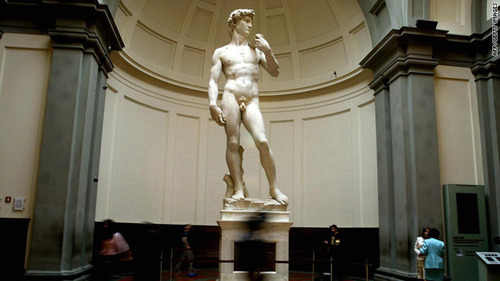
via cnn.com
The city of Florence and the national government of Italy are in a dispute over which of the two owns Michelangelo Buonarroti’s famous statue of David. The dispute is more than about just pride of ownership; it’s also about who should be getting how much of the annual $10 million in admission ticket sales from visitors paying to see the statue.
The claim by Florence has been put forth for many years, but more recently a request was made by Florence to the Italian government to hand over the earnings, on the basis of Florence’s right of ownership. Following the request, the Italian Heritage Ministry commissioned a study to determine the rightful owner.
Looking through centuries of archival material, two lawyers commissioned by the national government produced a nine-page document that concluded that David belongs to Italy. The major legal point they made was that between the time of Republic of Florence, which existed at the time David was created, until the unification of Italy in 1870, the city was part of a number of successor states and they did not provide a clear continuity in ownership. More importantly, the unified Italy was the final successor state of all the Italian states and so the inheritor of all the states’ assets.
The city’s argument is that there is a legal document that Italy was a party to from 1871 that decreed that the Palazzao Vecchio (the town hall outside of which David was located at the time) and everything in it was given to the city of Florence. The counter argument from the national givernment’s lawyers is that the document did not explicitly mention David, “even though by this time it had acquired an enormous symbolic value”. In addition, when David was moved to La Galleria dell’Accademia in Florence in 1873 (to bring it inside for conservation purposes), the city did not assert any rights to the sculpture. In fact, a year later, the mayor of Florence at the time claimed David belonged to the Italian government and for that reason billed Rome for its moving cost.
The Italian Heritage Minister stated that he hoped an amicable agreement could be worked out between Italy and Florence to avoid any further controversy.
The money for the admission to the state run L’Accademia gallery in Florence goes to the Italian government, and not the city. The gallery has 1.5 million visitors a year and Florence has to pay for cleaning and security in the area. The mayor doesn’t feel that it is fair that the burden of maintaining the city and its centuries-old buildings should be paid by its citizens without them being able to share in the profit its key attractions provide.
The ruling on David is considered even more dangerous because Florence also claims ownership of many pieces of art in other local state-run museums such as the Uffizi Gallery.
Michelangelo was commissioned in 1501 to create the sculpture for the city’s cathedral. However, when it was finished in 1504, it was placed in the Piazza Della Signoria at the entrance to the Palazzo Vecchio. It was considered a masterpiece from the beginning, even though David has a major flaw: an uncircumcised penis on one of the most famous Hebrews of all time.
A replica was placed in the Piazza della Signoria in 1910, which remains on view for the public for free.
Tuesday, August 10, 2010
I Love Monsters Band

The I Love Monsters commercial is one of four commercials that FreeCreditScore.com is televising to show each of the four finalists in the site’s contest to select its new band. The credit reporting company that owns the site, Experian, had a lot of success with its previous set of commercials for FreeCreditReport.com (note the name difference). In those commericials, a fake band sang a series of very popular jingles that brought a lot of attention to the site. That campaign is over, but to help introduce its new product, new website, Experian decided to reuse the concept, but this time hire a real band that would present its own sound and not just lip-sync to session recordings.
Experian did talent searches in New York, Chicago, and Los Angeles, using event people and promoters to find the best “undiscovered” local talent and have them apply. Experian also allowed bands from all over to submit videos of themselves for consideration. The candidates were narrowed down to four finalists by the company and those bands were then shown on TV for the first time during the MLB All-Star game in July, 2010. At that time, the contest was opened to the public to vote for their favorite. The voting contest continues through August 9th, 2010, after which the winner will be announced. Among other prizes, the winning band will be part of the FCS advertising campaign for 18 months.
Singer Brett Spigelman’s voice can be characterized as either addictive or nails on chalkboard (see video below), but either way it would cause the listening public to notice the advertisement. Brett (pictured below) graduated from Connecticut College in 2005, where he studied music and philosophy. He spent some time with a group called “Shorty 2 Inch”, and later in “4gether”. He has notably been involved with charity work, including AIDS Walk in New York and San Francisco.

Brett is on bass and vocals. The other members are Micah Weisberg on guitar and vocals, Jonathan Tortora on percussion, and Jeff Joseph Jeudy also on guitar and vocals.
I Love Monsters formed in early 2008. Three of the four members of the band, including Brett, met while in college. The fourth member, Jeff, was added later.
The group got the inspiration for its name from seeing a little boy crossing Sixth Avenue in New York City with his finger in his nose and wearing a shirt that said “I Love Monsters.” They are indie-rock, and considers their sound to be a mixture of dance rock and pop. Their stated influences include The Arctic Monkeys, Weezer, Phoenix, The Get Up Kids and The Beatles.
Their music is available for free download at http://ilovemonsters.bandcamp.com. The songs available are Spine, Satellites, Stop Pretending, Heart/Beat, Rescue, Practice with Your Heart, and Seen a Ghost.
The music from their song Heart/Beat was used in a clip on the show Entourage. Their music has also been used several times on commercials for the show American Pickers.
Sunday, August 8, 2010
David Archuleta Doesn’t Give Up On Love

The video for David Archuleta’s Something ‘Bout Love, the first song released from his new album, The Other Side Of Down, has been released. It shows a reflective and exuberant David wandering the streets and then going to a party, while thinking and singing about love.
The song is another brilliant and thrilling accomplishment by Archuleta. It was originally scheduled for its digital release on July 13th, but it was delayed a week to the 20th. His people explained that he “wants to give his fans WAY more than just a single, and needed an extra week to do it.” Archuleta clearly succeeded.
The album release was also postponed, from September 14th to October 5th. About the delay, his people said, “Like the last time we dealt with a date change, this one is definitely for the best. David would like to make sure he’s delivering the best possible album and he needs just a little more time to do it.”
About the nature of the album, Archuleta said, “Most of the songs on the album represent thoughts and experiences that I’ve personally gone through. I hope this album helps people understand more of where I’m coming from as an artist and as a person. It’s about moving forward in life, making progress in accomplishing your goals and dreams while appreciating what life has given you.”
About the video for Something ‘Bout Love (below), Archuleta explained, “The video and the song are about people who are feeling a little down and a little alone and just feeling a little frustrated with love or their situation in life. Even though you might feel down with love, there’s something about it you shouldn’t give up on.”
The video also allows people to see how well Archuleta is maturing, to see what he is going to look like as an adult instead of the cute kid on American Idol. The Honduran-American hottie is still looking good, although he should probably comb his bangs down.
Saturday, August 7, 2010
Ann Coulter As The Right Wing Judy Garland
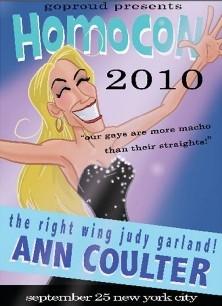
Coulter claims she is not anti-gay, saying, “I do want to point out one thing that has been driving me crazy with the media — how they keep describing Mitt Romney’s position as being pro-gays, and that’s going to upset the right wingers. Well, you know, screw you! I’m not anti-gay. We’re against gay marriage. I don’t want gays to be discriminated against. … I don’t know why all gays aren’t Republican. I think we have the pro-gay positions, which is anti-crime and for tax cuts. Gays make a lot of money and they’re victims of crime. No, they are! They should be with us.”
“The gay left has done their best to take all the fun out of politics, with their endless list of boycotts and protests. Homocon is going to be our annual effort to counter the ‘no fun police’ on the left,” said Christopher Barron, Chairman of the Board of GOProud. “I can’t think of any conservative more fun to headline our inaugural party then the self-professed ‘right-wing Judy Garland’ – Ann Coulter.”
Homocon 2010 will take place in New York City on the evening of Saturday September 25th. Adds Barron: “I can promise you, Homocon 2010 will be a hell of a lot more fun than chaining yourself to the White House fence.”
3 Musketeers Candy Bar

Do you know how the 3 Musketeers® candy bar got its name?
The 3 Musketeers® Bar takes its name from the original design of the product, which was three pieces and three flavors: vanilla, chocolate, and strawberry. It was first sold that way in 1932 by the Mars candy company. Supposedly, during WWII, due to difficulty in getting vanilla and strawberry flavorings, Mars changed the candy bar to be all one flavor.
How is it made?
The 3 Musketeers® Bar is made of chocolate-flavored nougat covered with milk chocolate. The nougat center is first formed into very large slabs, which are cut to size, and after the centers are formed they are coated with thick, rich milk chocolate, through a process called “enrobing.” The actual enrobing process begins when the centers pass through a continuous curtain of liquid chocolate, which coats the top and sides of the bar. At the same time, a rotating chocolate covered wheel beneath the mesh belt coats the base of the bar. To ensure an attractive, glossy, smooth coating, the chocolate must be just the right temperature. The fully enrobed bar is then cooled and prepared for wrapping.
What is nougat?
Nougat is made by whipping egg whites until they are light and frothy. Sugar syrup is then added, stabilizing the foam and creating “frappe.” A number of other flavoring ingredients are then added to the frappe; each ingredient creates nougat with a different taste.
Easy A
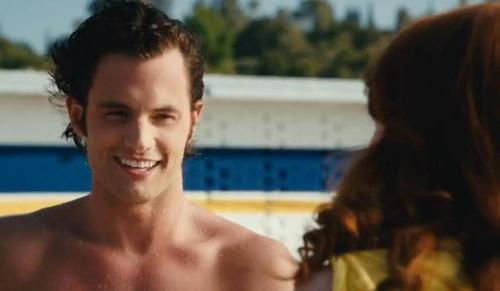
September 17th, 2010 is the release date for the movie Easy A. It looks like it is going to be hilarious.
After a little white lie about losing her virginity gets outs, Olive, a clean cut high school girl (Emma Stone) sees her life paralleling Hester Prynne’s in The Scarlet Letter, which she is currently studying in school - until she decides to use the rumor mill to advance her social and financial standing. She wears the letter A and the process becomes both the most popular and hated girl in school.
Olive pretends to lose her virginity to a gay friend to help his social standing. Word gets around with the unpopular male set in school and others in that group want her to do the same for them. She starts a business in creating the appearance that the unlayable have gotten laid. Somewhere along the line she falls for Woodchuck Todd (Penn Badgley).
Emma Stone is wonderfully funny in this film and makes it a must see.
Friday, August 6, 2010
Banana Republic Herring-boner Pants

The Banana Republic states that their tailored herringbone suit pant is available for both “big” and tall men, and to prove the former, their photo of the pants showed an example of a really big man (see above). The description on their website stated, “Pure wool offers a luxe softness in our slimmer, more tailored suit pant. The fine, herringbone pattern adds classic sensibility.” It also appears to offer some luxe stimulation with a slim fit that shows what a man has to offer. The patten may add some classic sensibility, but it doesn’t add any modesty to keep within polite society’s sensibilities.
Enter the wood-killing airbrush. Apparently the web prudes complained and BR decided they needed to doctor their image (see below). No word on how much sales went limp after the original herring-boner pants were replaced with the Ken doll version.

Wednesday, August 4, 2010
Nick Jonas Co-chairs Reagan Youth Leadership

As part of the celebration in 2011 of the 100th anniversary of the birth of President Ronald Reagan, a National Youth Leadership Committee, representing America’s next generation of leaders, has been formed to help honor his legacy. The committee consists of 35 young people, all under the age of 25, and includes race car drive Marco Andretti and speedskater J.R. Celski. There are four co-chairs for the committee, including singer Nick Jonas. The committee will participate in commemorative events during the Centennial Celebration.
About Reagan, Jonas said, “My father and my family were supporters of Reagan,” Jonas said. “I’m proud to be a part of this. It’s amazing.” Jonas also said in a statement, “Ronald Reagan is a personal hero of mine. I admire the way he stood up for causes he believed were right, no matter what.”
It was noted that the participants were selected on the basis of all having been inspired in a personal way by Reagan’s vision of freedom and by his leadership.
Sunday, August 1, 2010
The Poets Dance

“As Seen On TV”, the Rockford, Illinois band The Poets Dance is gaining a lot of nationwide popularity thanks to its appearance in a commercial for FreeCreditScore.com. The catchy tune along with the band’s unique electronic sound and visual appeal is causing a lot of people to look-up who the band is and how they can hear more of their music.
The commercial that The Poets Dance is in is one of four commercials that FreeCreditScore.com is televising to show each of the four finalists in the site’s contest to find an official band to use in its advertising. The credit reporting company that owns the site, Experian, had a lot of success with its previous set of commercials for FreeCreditReport.com (note the name difference). In those commericials, a fake band sang a series of very popular jingles that brought a lot of attention to the site. That campaign is over, but to help introduce its new product, new website, Experian decided to reuse the concept, but this time hire a real band that would present its own sound and not just lip-sync to session recordings.
Experian did talent searches in New York, Chicago, and Los Angeles, using event people and promoters to find the best “undiscovered” local talent and have them apply. Experian also allowed bands from all over to submit videos of themselves for consideration. The candidates were narrowed down to four finalists by the company and those bands were then shown on TV for the first time during the MLB All-Star game in July, 2010. At that time, the contest was opened to the public to vote for their favorite. The voting contest continues through August 9th, 2010, after which the winner will be announced. Among other prizes, the winning band will be part of the FCS advertising campaign for 18 months.
The Poets Dance refer to their style as rocktronica, although Experian has labeled them as progressive electro-rock. On the FreeCreditScoreBand.com site, it also states that, “The name, The Poets Dance, encompasses what the style of music is all about. The instrumentation combines synthesizers and guitars with up-beat rhythms to really ignite an energy in the sound, while being led with poetic and intriguing melodies that all demographics can relate and latch on to.”
About themselves, the band says, “The Poets Dance music arises from a variety of genres, incorporating progressive club rock elements to shape a sound that is truly unique. The guitars and bass drive hard and are intricately entwined into synthesizers that explore the depths of electronic manipulation. A trio of vocalists empty their lungs into smooth, poetic lyrics, on top of a heart-pounding beat that will leave you breathless yourself.”
The band has been around for about six years, but has gone through several name changes. At one time is was known as “Kissing Kimberly”, but with the addition of another lead vocalist, Luke Larson, in 2006, the band changed its name to “A Perfect Paradigm”. At some point it became just “The Paradigm” and then more recently, became “The Poets Dance.” The name changes reflected some changes in the music style as the group matured. The current name reflects a passion for dance music coupled with emotionally charged lyrics.
Early in 2010, the band released an album titled “2013”. They will be releasing a 6 track EP later this year.
Here are the band members:
- Luke Larson - Lead Vocals / Guitars
- Ryan D. Jensen - Lead Vocals / Synthesizers
- Sean Gomez - Vocals / Bass
- Andrew “Dobber” Dobson - Auxiliary Synthesizers
- Jarrett Kimberly - Drums / Percussion
Wednesday, July 28, 2010
Back To The Motherboard In Tron: Legacy
via wired.com
With Comic-Con came more information and more visuals from the highly anticipated Disney movie Tron: Legacy. It’s the sequel to the 1982 movie Tron, an anthropomorphic view of what life would be like inside a computer if softwear were people-like and not just electronic bits.
The original movie had a message, but perhaps best known for its exciting (in 1982) sci-fi visual effects and images. The sequel had to live up to having an up-to-date, 2010 version of the best in distinctive electronic imagery, and so far it looks like it may have succeeded.
The 1982 film had a story that was concerned with warning about computers knowing too much about us and controlling our lives. Now we accept that as just the way it is, so the new movie had too look for modern concerns for its storyline. About the new message, the writer/director said, “Technology is all about bringing people together, supposedly, and now there’s this sense that technology may have a dark side that keeps us from connecting with each other, and I think this film examines that problem.”
The first movie used scenes of video game action within the computer as a showcase for the imagery. In the new movie, combatants once again fight it out in the virtual world, hurling discs and riding light cycles. They also still wear suits that have the movie’s trademark glow, expect in the modern version. costumes shine more brightly, due to electroluminescent lamps woven into the casts’ tight-fitting suits. Before “action!” was said on set for each scene, there would be a call to “light ‘em up!” To make the new movie even more visually stunning, it was filmed in 3-D rather than having it added post-production.
Actor Jeff Bridges stars in Tron: Legacy, reprising the role of videogame designer Kevin Flynn. Between the time of the first and second films, it is revealed that the character has been lost in the network for many years. His son, played by Garrett Hedlund, enters cyberspace to look for him. There are again life-and-death battles between the inner world characters, played out in the dark, foreboding, but shiny environment that most of the movie takes place in.
The original movie grossed only $33 million in the United States in 1982. Expect the sequel to do much better.
With Comic-Con came more information and more visuals from the highly anticipated Disney movie Tron: Legacy. It’s the sequel to the 1982 movie Tron, an anthropomorphic view of what life would be like inside a computer if softwear were people-like and not just electronic bits.
The original movie had a message, but perhaps best known for its exciting (in 1982) sci-fi visual effects and images. The sequel had to live up to having an up-to-date, 2010 version of the best in distinctive electronic imagery, and so far it looks like it may have succeeded.
The 1982 film had a story that was concerned with warning about computers knowing too much about us and controlling our lives. Now we accept that as just the way it is, so the new movie had too look for modern concerns for its storyline. About the new message, the writer/director said, “Technology is all about bringing people together, supposedly, and now there’s this sense that technology may have a dark side that keeps us from connecting with each other, and I think this film examines that problem.”
The first movie used scenes of video game action within the computer as a showcase for the imagery. In the new movie, combatants once again fight it out in the virtual world, hurling discs and riding light cycles. They also still wear suits that have the movie’s trademark glow, expect in the modern version. costumes shine more brightly, due to electroluminescent lamps woven into the casts’ tight-fitting suits. Before “action!” was said on set for each scene, there would be a call to “light ‘em up!” To make the new movie even more visually stunning, it was filmed in 3-D rather than having it added post-production.
Actor Jeff Bridges stars in Tron: Legacy, reprising the role of videogame designer Kevin Flynn. Between the time of the first and second films, it is revealed that the character has been lost in the network for many years. His son, played by Garrett Hedlund, enters cyberspace to look for him. There are again life-and-death battles between the inner world characters, played out in the dark, foreboding, but shiny environment that most of the movie takes place in.
The original movie grossed only $33 million in the United States in 1982. Expect the sequel to do much better.
Tuesday, July 27, 2010
Raspberry Brie Panini
 I love panini. There’s something wonderful in how a plain meat and cheese sandwich can be transformed into a deliciously satisfying experience. I don’t how it happens, but the pressing of the bread, the oozing of the melted cheese, and the mixture of other stuffings all combine to make a special treat that makes my mouth and tummy quite satisfied.
I love panini. There’s something wonderful in how a plain meat and cheese sandwich can be transformed into a deliciously satisfying experience. I don’t how it happens, but the pressing of the bread, the oozing of the melted cheese, and the mixture of other stuffings all combine to make a special treat that makes my mouth and tummy quite satisfied.I see this recipe for a raspberry and brie panini and I don’t know if I would find it as satisfying as a meat based sandwich, but it sure is pretty to look at. I want to try one.
I don’t cook, although I do have an unopened panini grill that I received as a present last Christmas. Actually, I had forgotten about it until I started writing this note.
Now I’ve gotten myself so worked up thinking about my love of panini, I want to unbox it tomorrow and give the little appliance a try. It won’t be raspberry and brie, but I may be able to able to cobble together some fat-free swiss cheese, fat-free hot dogs, and the ends of the loaf of bread that I haven’t thrown out yet.
The ingredients don’t matter. The panini process makes anything remarkable. (Or at least, we’ll see.)
The Italian word panino refers to a small bread roll. It is the diminutive form of pane (“bread”). The plural is panini, which when you have it, linguistically justifies eating more than one.
photo and recipe via rockrecipes.blogspot.com
Saturday, July 24, 2010
Flexibility
via godsnmonsters.tumblr.com

With that kind of limberness and that package, why is he bending backwards?

With that kind of limberness and that package, why is he bending backwards?
History of Alphonse Maria Mucha
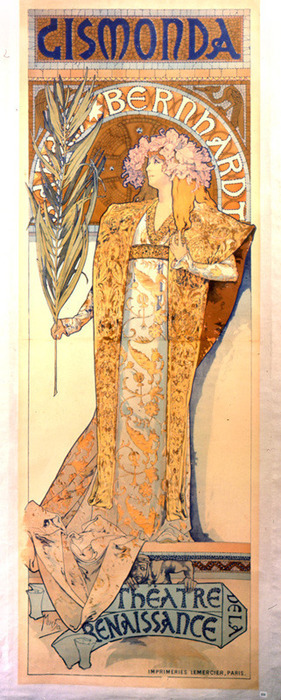
July 24th, 2010, is the 150th anniversary of the birth of the renown Czech artist Alphonse Maria Mucha. Mucha is known for his works in several mediums in the Art Nouveau style, which he helped to popularize around the end of the 19th century.
The work that first brought him fame was a poster of the actress Sarah Bernhardt for the play Gismonda (seen here). Its creation story is that on Christmas Eve, 1894, Mucha was doing a favor for a friend, a printer, correcting proofs. On that day Bernhardt contacted the printer with a request for a new poster for her play, which she needed as soon as possible. All the printer’s artists were on holiday, so Mucha volunteered to create the poster. Bernhardt was the queen of celebrities in her day and her wishes were quickly addressed.
The resulting poster, which Mucha created in two weeks, was an instant success and revolutionized poster design. The long narrow shape, the subtle pastel colors and the stillness of the near lifesize figure introduced a look that was quite novel for the time. The poster was so popular with the Parisian public that collectors were known to bribe the laborers who hung them to hand them over, or simply to go use razors to cut them down from the walls. Bernhardt was so satisfied with the poster she gave Mucha a muli-year contract to produce stage and costume designs as well as posters for her.
After that, his posters, panneaux decoratifs, calendars, prints, magazine and book illustrations attained enormous popularity. With his exquisite decorative motifs, abundance of ornamental pictorial elements, and beautifully graceful lines, his compositions shaped the the Art Nouveau style.
The “le style Mucha” became the pattern for a whole generation of graphic artists and draftsmen.
His hallmark was the idealized, stylized figure of a graceful woman, loosely but inseparably framed in an ornamental system of flowers and foliage, symbols and arabesques. As this was one of the most widespread pictorial motifs of the turn of the century, the Mucha Style became for a while to be regarded as synonymous with the whole Art Nouveau movement.
Mucha actually disliked the name “Art Nouveau”, or the idea that it was a movement, arguing that art was eternal and therefore could not be “noveau.” He insisted he derived his main inspiration from Czech artistic traditions, rather than subscribing to the doctrines of any particular school.
A hundred years later, Art Nouveau is still a wonderful visual stimulation.
Labels:
art,
Art Nouveau,
Czech,
Mucha
Monday, July 19, 2010
A New Caravaggio Painting Found?
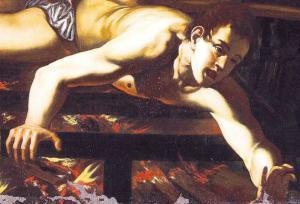
On the coincidental 400th anniversary of artist Caravaggio’s death, the Vatican’s newspaper published a story that a previously unknown painting by Caravaggio had been discovered. It had been in the possession of the Society of Jesuits in Rome.
The subject of the painting is a semi-naked St. Lawrence. The saint was grilled to death in 258 AD, and accordingly the painting shows Lawrence over the flames. According to legend, during his torture Lawrence cried out “This side’s done, turn me over and have a bite.” (Assum est, inquit, versa et manduca.”) This is why Lawrence is the patron saint of comedians, butchers and roasters.
Stylistically, the painting is similar to the works of Caravaggio (real name Michelangelo Merisi), but that’s not conclusive. A lot of art students created works in the style of whomever they admired.
Thomas Eakins’ The Gross Clinic Back On View
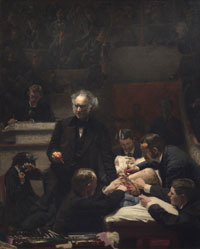
After a year of conservation and restoration work, Thomas Eakins’ painting Portrait of Dr. Samuel D. Gross (The Gross Clinic) is going back on view at the Philadelphia Museum of Art. The painting is considered to be the greatest American painting of the 19th century.
Because of the work done on it to remove and fix problems caused by age and past restoration and conservation work, the painting is going to look different from how you saw it before, either in person, or in any art text book you ever had. It’s intended to look now more like how the artist painted it.
This painting was the object of an expensive battle to keep it in its native Philadelphia. When the previous owner, Thomas Jefferson University, decided to sell it, it made the deal with the National Gallery of Art and the Crystal Bridges Museum of American Art in Bentonville, Arkansas. The painting would leave its home city and move to rural Arkansas. The $68 million purchase, a record for pre-WWII American painting, was being funded with the assistance of Alice Walton (of the Wal-Mart Waltons). Fortunately, the Thomas Jefferson University agreed to sell it instead to the Philadelphia Museum of Art and the Pennsylvania Academy of Fine Arts if they could match the price. They agreed and the painting stayed in Philadelphia.
Russian Billionaire Boosts $2 Billion Faberge Collection
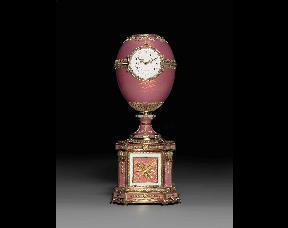
Russian billionaire Alexander Ivanov says he has spent 90 million euros ($107.8 million) in the last year to add 100 additional items to a collection of 3000 Faberge items he says are worth $2 billion.
It is surprising that there could be that many items in total in the world, let alone in one person’s collection.
Ivanov shows his collection in his own museum that he has in the German spa town of Baden Baden. He chose that location because it has 8 million visitors a year and historically has been popular with the Russian well-to-do. In the 19th century, prominent visitors included writer Fyodor Dostoyevsky and members of the Russian royal family. Ivanov plans to open a second museum in the Croatian city of Dubrovnik, another popular European tourist spot.
Ivanov’s biggest purchase was the 1902 Faberge egg made as an engagement gift for Baron Edouard de Rothschild. Ivanov bought it in 2007 for $18.5 million, and says it’s Faberge’s “finest ever.” The gold and pink enamel egg has a clock and a diamond-set cockerel that pops up every hour and flaps its wings (see photo above).
Ivanov’s latest purchases include a 27-inch high silver clock given to Russian Emperor Alexander III and his wife by relatives in 1891 for their 25th wedding anniversary. He wouldn’t say how much he paid.
Faberge pieces prove that a thing of beauty is a joy forever.
Sunday, July 18, 2010
Ryan Reynolds’ Green Lantern Suit Is Painted On
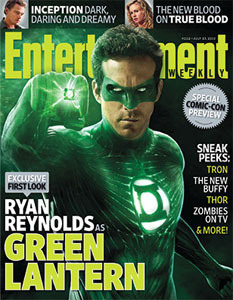
To me, most movies based on comic book superheroes are a major miss. They focus on a lot of special effect shots and spend little on the character development and plot that might make the films interesting.
Sometimes the actors can make all the difference as to whether the movie is worth seeing or not. For example, Brandon Routh as Superman and Chris Evans as the Human Torch made their films worth spending the money to rent them.
The upcoming movie about Green Lantern might be worth seeing for the sake of the star, Ryan Reynolds. I’ve liked him going back to when he was on Two Guys, A Girl, And A Pizza Place. He’s got the talent to turn even a farce like Van Wilder into an entertaining movie.
It’s been revealed that the suit he “wears” in Green Lantern is actually digitally painted on, using a motion capture suit (covered with computer sensors) and CGI to add the GL suit later. It’s said that the suit “hugs his every muscular ripple. Little is left to the imagination.” This might make the movie something to see just for this reason, as Reynolds is known to be well-developed.
Because it’s a special effect, the muscle definition will probably be digitally enhanced, covering the real Ryan. It would have been better to paint him all over with liquid latex. I’d pay the theater ticket price just to see that on a big screen (especially if it were 3-D!).
Chace Crawford Makes His Assistant Wet
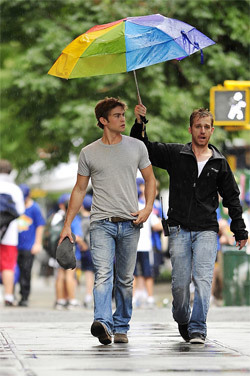
Is this for real? Chace Crawford is shown above supposedly with a personal assistant holding his Pride umbrella for him as he walks down the street. It doesn’t seem possible that someone would be so arrogant as to have someone else do this for them, when they have nothing but their cap in their hands and could hold the umbrella themselves.
It shows how PAs are psychotic. How could you have so little self-esteem that you would agree to do this? I would tell CC to go f*** himself with it and appropriately enjoy all the colors of the rainbow.
House slaves had to do this kind of thing because they would be punished if they didn’t. PAs do it because they want to. Sick.
On the other hand, if Chace likewise wants assistance so that he can use the urinal but have someone else hold it, I am so there.
Jeffery & Cole Casserole Gone Bad
 via trickwire.wordpress.com
via trickwire.wordpress.com The gay comedy team of Jeffery Self and Cole Escola are back on LogoTV for their 2nd season of their comedy sketch show Jeffery & Cole Casserole. While the 1st season of Jeffery & Cole Casserole was a hilarious helping of absurdity, the 2nd season appears to be only a caricature of the first. The entertaining quality of a show about two guys doing amateur videos now looks like just two guys doing an amateur video. It’s sad to see something good go downhill so fast.
There is a rumor that Logo paid Self and Escola a very small sum of money for their work. Perhaps for the second season, the pair decided to give the company what it paid for, and intentionally decided to deliver a load of crap. It doesn’t help the viewer if that were true, but at least it would make the two of them not look so tapped out.
Friday, July 16, 2010
James Wolk

via trickguys.com
Finally! James Wolk is coming back to TV. He was first noticed in the Hallmark Hall of Fame presentation of Front of the Class in 2008. His superb acting ability, cuteness, and beefy body gave viewers both an emotional and physical woody. He definitely left people wanting more, but he came out of nowhere, made a splash and then wasn’t seen anywhere else. So it’s about time he was back on TV getting people sweatingly excited.
Wolk will star in Fox’s new show Lone Star, which debuts in Fall, 2010. The trailer is out and it can be seen that Fox is intent on promoting all of Wolk’s assets. Sizzling.
Village People Upset About YMCA Name Change
via advocate.com
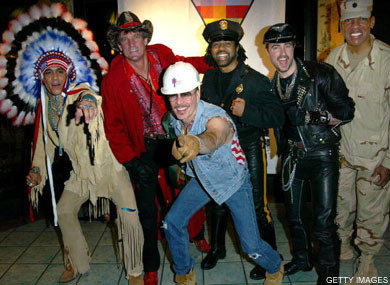
On July 12th, the organization known as the Young Men’s Christian Association, or YMCA, announced that it would shorten it’s name to just “Y”. Most people have probably been calling it that for a long time, so the name change shouldn’t have much effect on its patrons. However, one set of people who have a stake in what the organization is called is the long-lived Village People. Their song “YMCA” has sold more than 15 million units and is the group’s best selling single. Due to its never-ending popularity at sporting and other events, it’s the song that keeps the group alive and viable.
The group says they will of course continue to sing the song with all four letters intact. Perhaps they should instead repeat the initial letter for all four notes, but with the last three meaning “why, why, why”, as in, why don’t straight people understand even 30 years later that they are singing about and celebrating having gay and/or male-male bathhouse-like sex at the YMCA? Someone should teach them to do more appropriate positions during the song rather than forming letters. Replace the M, C, & A arm motions with the bend-over, the crouch down, and the leg lift.

On July 12th, the organization known as the Young Men’s Christian Association, or YMCA, announced that it would shorten it’s name to just “Y”. Most people have probably been calling it that for a long time, so the name change shouldn’t have much effect on its patrons. However, one set of people who have a stake in what the organization is called is the long-lived Village People. Their song “YMCA” has sold more than 15 million units and is the group’s best selling single. Due to its never-ending popularity at sporting and other events, it’s the song that keeps the group alive and viable.
The group says they will of course continue to sing the song with all four letters intact. Perhaps they should instead repeat the initial letter for all four notes, but with the last three meaning “why, why, why”, as in, why don’t straight people understand even 30 years later that they are singing about and celebrating having gay and/or male-male bathhouse-like sex at the YMCA? Someone should teach them to do more appropriate positions during the song rather than forming letters. Replace the M, C, & A arm motions with the bend-over, the crouch down, and the leg lift.
Thursday, July 15, 2010
Jon Benet Memorial Beauty Set
If I were a child receiving this, I'd use the mirror to keep one eye looking behind me for any family members who might wander into my room. Just saying.
Wednesday, July 14, 2010
Which German Soccer Player Is Gay?
The German gay web site Queer.de took a poll of its readers to find out which German soccer player would be the least surprise if he came out. As of the writing of this post, Arne Friedrich had the most votes followed by Philipp Lahm, who just got married after the end of the World Cup. I would take Lahm or Podoloski into the fold anyday, but it doesn’t look like Lahm fits the bill. Are there gay German soccer players?
B) 128 votes, 7.1%: Mirolsav Klose
C) 405 votes, 22.4%: Philipp Lahm
D) 70 votes, 3.9%: Thomas Müller
E) 328 votes, 18.2%: Manuel Neuer
F) 126 votes, 7.0%: Mesut Özil
G) 187 vote, 10.4%: Lukas Podolski
H) 136 votes, 7.5%: Outings impossible - the guys are just too diverse
All football players say they are straight - if it would be different, whose outing would surprise you the least?
A) 425 votes, 2 3.5%: Arne Friedrich
B) 128 votes, 7.1%: Mirolsav Klose
C) 405 votes, 22.4%: Philipp Lahm
D) 70 votes, 3.9%: Thomas Müller
E) 328 votes, 18.2%: Manuel Neuer
F) 126 votes, 7.0%: Mesut Özil
G) 187 vote, 10.4%: Lukas Podolski
H) 136 votes, 7.5%: Outings impossible - the guys are just too diverse





